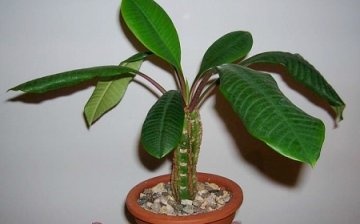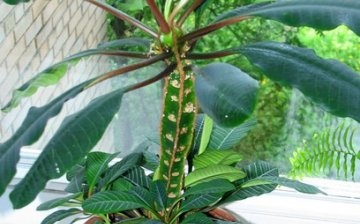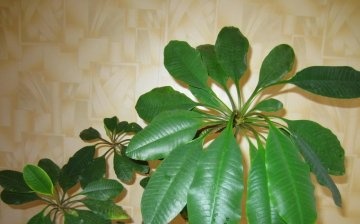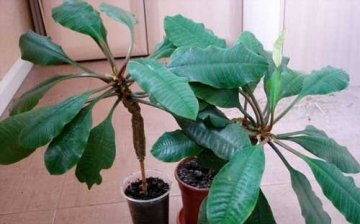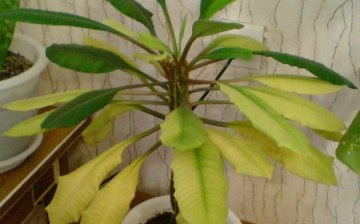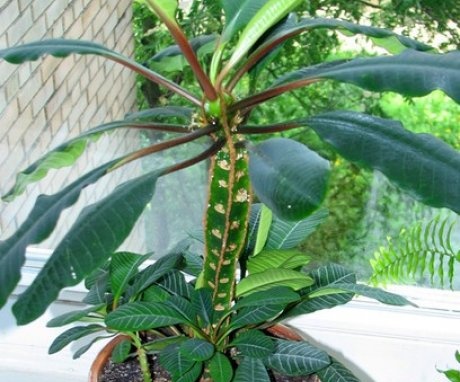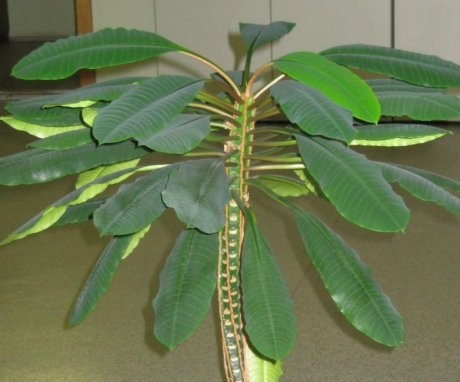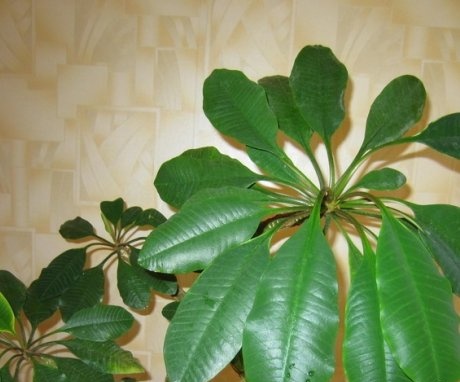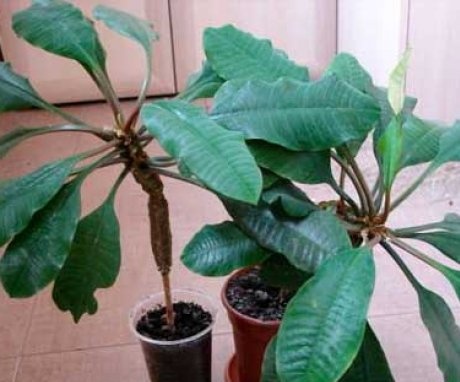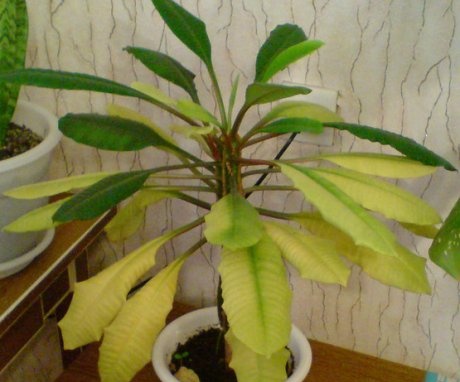Euphorbia white-veined - a beautiful and unpretentious houseplant
In indoor floriculture, plants from the euphorbia family are widespread. They are appreciated for their unpretentiousness and beautiful appearance. One of the most common species is the white-spiked spurge.
Content:
- Description of white-lobed milkweed
- Growing conditions
- Houseplant care
- Reproduction
- Pest and disease control
Description of white-lobed milkweed
Euphorbia white-veined - widespread in indoor floriculture culture belonging to the euphorbia family. This plant comes from Madagascar. Very often it is called as a cactus or even a palm tree, although it has nothing to do with them.
This culture got its name for the white milky sap, which can be seen on the cut of the trunk or leaves.
Milkweed juice is very bitter and poisonous; if it gets on the skin or mucous membranes, it can lead to severe allergic reactions and burns. Plants of this species have a massive pentahedral trunk with thorns, at the top of which are leaves. The peduncle of the milkweed is inconspicuous, it is located in the leaf sinuses and does not represent any decorative value. When ripe the seeds can be scattered up to 4 meters.
In older specimens, the stem may begin to branch out, giving the plant the shape of a candelabrum. In indoor culture, this type of milkweed has become widespread since the beginning of the 20th century.
Growing conditions
Like any other indoor plant, milkweed has its own requirements for the level of illumination, watering, soil and temperature. Only when favorable conditions are created, he will be able to please with a beautiful appearance:
- Lighting... Like most plants native to the subtropics, Euphorbia requires bright but diffused light. He is also able to put up with a lack of illumination for a long time, but in this case the plant begins to shed its leaves. Leaves can get severe burns from direct sunlight. In order for milkweed plants to develop evenly and not become one-sided, they must be periodically turned over. This culture responds very well to outdoor content during the summer. By the fall, the plants are strong and stocky, and the leaves take on a rich, bright green color. When placing milkweed in the garden, it is imperative to choose places with diffused light and protected from the winds.
- Watering... Watering this succulent is necessary as the soil dries out. In this case, it is best to use soft, settled water. When content milkweed during the winter period in cool rooms, watering should be reduced to a minimum. This will help prevent the occurrence of various diseases and rot. Succulents do not need high humidity in the surrounding air for successful growth. It develops quite normally even near batteries and other heating devices, which undoubtedly can be attributed to the number of its advantages.In the absence of watering for a long time, the spurge can shed all the leaves, but from this state it is easily restored. After all, the trunk of this plant contains a large supply of moisture and nutrients.
- Priming. Euphorbia is absolutely not picky about the composition of the soil. For its cultivation, a ready-made soil mixture for succulents is quite suitable. Also, the soil can be prepared independently, using sand, peat and leafy soil mixed in equal proportions.
- Pot. The choice of a pot for this succulent should be approached more carefully. Root system milkweed is superficial, so a flat and wide pot would be ideal for it, in which it is necessary to make a massive drainage layer. When placing large specimens, it is best to choose a flowerpot deeper so that there is space under the drainage layer for laying stones, which will give additional stability to the pot and prevent the plant from turning over.
- Temperature. Euphorbia is native to the subtropics, so room temperature is best when kept during the winter period. He reacts very badly to her lowering. If the plant is still kept cool, then watering reduced to a minimum. With excessive moisture combined with a low temperature, the plant is likely to die from decay.
Houseplant care
Euphorbia is absolutely not a demanding culture and does not need any special attention. All measures for caring for him can be summarized as follows:
- Young plants need annual transplant... Older specimens are transplanted every 2 years or as needed. In case of salinization of the soil, you can get by simply by changing its top layer.
- During the period of intensive growth, the plant needs dressing... To do this, you can use a special fertilizer for succulents. It must be entered at intervals of 2 times a month.
- Euphorbia responds very well to periodic spraying during the summer season. Also, once a month, he needs to arrange a hygienic shower in order to cleanse his leaves from dust accumulated on them.
Reproduction
Euphorbia can reproduce both vegetatively and seeds... In the first case, during the summer period, cuttings are cut from it, which must immediately be placed in a container with warm water. This technique allows you to wash out the milky juice from them, which inhibits the rooting process.
After that, the slices are dipped in charcoal powder, which will further reduce the likelihood of rot. Cuttings treated in this way are left for further drying for 2 days.
After this period, the prepared planting material is planted. For these purposes, you can use peat tablets or a sand-peat mixture.
Successful rooting is facilitated by maintaining the air temperature at 20 degrees and a high level of illumination.
Seed propagation is simpler:
- Very often, scattered milkweed seeds sprout on their own right in the pot. The florist just needs to plant young specimens in a separate container.
- If the seeds were purchased, for planting them it is necessary to stock up on a sand-peat mixture. Previously, the surface of the substrate must be well moistened; for these purposes, it is best to use a spray bottle.
- Then the seeds spread out evenly and slightly pressed into the surface.
- To speed up the process and improve germination, seeds can be pre-treated with special growth hormones.
- Until the emergence of shoots, the planting container must be ventilated and spray ground surface.
When optimal conditions are created, the first shoots can be seen 10 days after sowing. The seedlings of this succulent grow very quickly. After they get stronger, they begin to transplant them into separate pots.
Pest and disease control
Subject to growing conditions spurge very rarely affected pests... In some cases, a spider mite, scale insects or mealybugs may appear on it. To combat them, special insecticides are used.
Of the diseases affecting euphorbia, it is worth noting diseases of a fungal nature.
For their treatment, use fungicidesthat have a systemic effect. Another problem that can be encountered while growing this succulent is rot. In most cases, they appear due to low temperatures and drafts. At the first signs of their manifestations, watering should be stopped, and the pot with the plant should be moved to a warmer place.
Caring for the milkweed is not a problem. If the growing conditions are observed, a large and beautiful plant can be obtained in 2-3 years.
More information can be found in the video:



